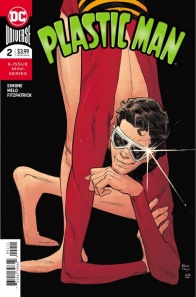Despite artist Adriana Melo’s consistently great character designs and writer Gail Simone’s generally witty script, an awkward story structure and somewhat convoluted plot combine to keep “Plastic Man” #2 from achieving greatness. (Warning: minor spoilers ahead.)
Written by Gail SimoneCover by Bilquis Evely
with Mat Lopes
Illustrated by Adriana Melo
Colored by Kelly Fitzpatrick
Lettered by Simon BowlandEel didn’t like it when a spy blackmailed him over his secret identity, and then a kid found out, and now the dancers at his club know and the concept of a secret identity has gotten stretched way the heck out of whack. But the dancers are helping him find the kid, who was nabbed by some bad guys who don’t know his secret identity, just his costumed persona, which is still a terrible day, even in his pretty rotten life.
“Plastic Man” #1 ended with a brilliant sequence. On the second to last page, a dying petty gangster tried to reveal the identity of his killer by scrawling the initials JLA on the wall in blood. Then, in the final panel – drawn from Plastic Man’s point of view – we saw a trio of well armed soldiers pointing their guns at our titular hero as one of them barked, “If you do not comply immediately, we will be forced to shoot.”
Obviously, it’s beyond absurd to think that there’s any real chance the marquee character of “Plastic Man” could actually die, but that’s not exactly the point. The first issue struck a nice balance, introducing several key plot points while giving us a great introduction to a unique and likable character who suddenly finds himself in a desperate life-or-death situation. It felt authentic. It felt organic. It had momentum. On top of that, the final scene delivered a wonderfully constructed cliffhanger: equally fraught with tension and ripe with possibility – not always an easy task.
Unfortunately, in the intervening weeks between books one and two, all of the tension and drama quietly drained away. Rather than jumping right back into the action and paying off the cliffhanger, the story flashes forward to an unknown time in the future. Instead of continuing action, we get a series of loosely connected panels that create a seemingly linear montage of Plastic Man desperately looking for someone. Who? We don’t really know. Why? We have yet to learn. Even worse, it’s not yet clear why we should care. Consequently, when Plastic Man tugs his elastic face in angst and exclaims, “Where the *&^% is Pado Swakatoon!” it feels like a disconnect. Especially since we have yet to return to the cliffhanger scene and learn exactly how our hero extricated himself from seemingly certain demise.
Admittedly, throughout the first four pages the art is spectacular. I mean, this is what we paid for, right? Whatever twists and turns the story may take, we’re ultimately here to watch Plastic Man do his thing, stretching his arms, neck and legs and dynamically changing shape from a cannon, to a tank, to a cat. Indeed, illustrator Adriana Melo’s sight gags are generally clever and well rendered, while colorist Kelly Fitzpatrick nicely infuses Plastic Man’s iconic red, yellow and black color scheme into every scene without making it feel redundant or overblown. There’s a goofy but accessible truthiness to it all, even as Plastic Man’s arm spans four continuous pages or his legs stretch three stories high.
Similarly, writer Gail Simone perfectly captures Eel O’Brian/Plastic Man’s inner struggle as a petty criminal who’s suddenly found himself thrust into the unfamiliar and unwelcome role of a hero with super powers. With a self-deprecating, stream-of-consciousness inner monologue and equally snarky dialogue, Simone paints a vivid picture of a man genuinely grappling with his fate, knowing he needs to do better, but not knowing how to do so. It’s a definite balancing act. Firmly rooted in the classic “petty criminal tries to turn things around a become a better person after a life-changing event” trop, things could easily devolve into unabashed cliché. Thankfully, Simone gingerly avoids these obvious pitfalls, so when Eel O’Brian refers to himself as, “The least worthy recipient of a miracle ever,” it feels authentic and genuine.
Continued belowIn the end, Melo’s visual storytelling is absolutely on point. With expert paneling, a couple of nicely done splash pages and an excellent visual rhythm that beautifully balances of action sequences and facial expressions, there’s an indisputable energy that keeps driving the story forward. Unfortunately, a somewhat awkward plot and propensity to keep adding characters and even more subplots, the issue tends to feel a bit overly – and unnecessarily – ambitious.
Plastic Man (and his alter ego Eel O’Brian) is a tremendously engaging character. Simone expertly captures his voice while Melo delivers some truly outstanding character designs and dynamic action sequences. That alone is more than enough to keep us hooked. The plot doesn’t need to be wildly inventive or full of unexpected twists and turns. In the long run, the creators might be better off just keeping things simple.
Final Verdict: 6.9 “Plastic Man” #2 is very well drawn and generally well written, but the plot doesn’t hang together. It’s a fun, entertaining read, but not entirely satisfying.




